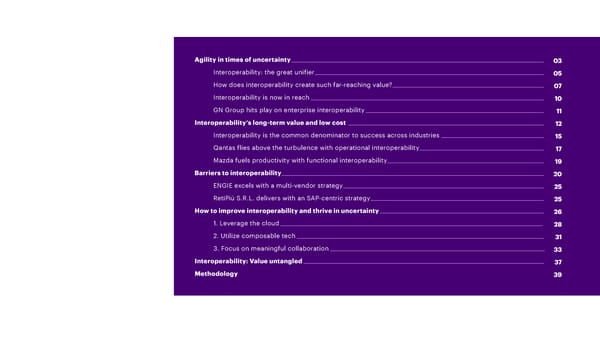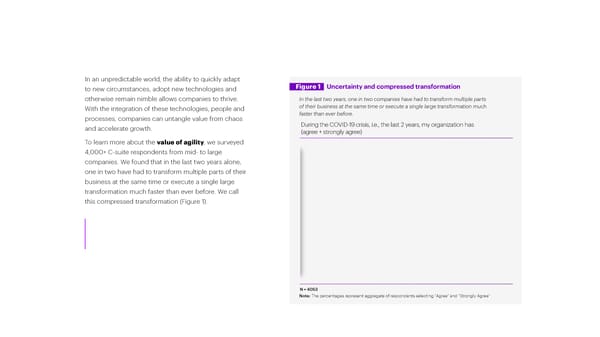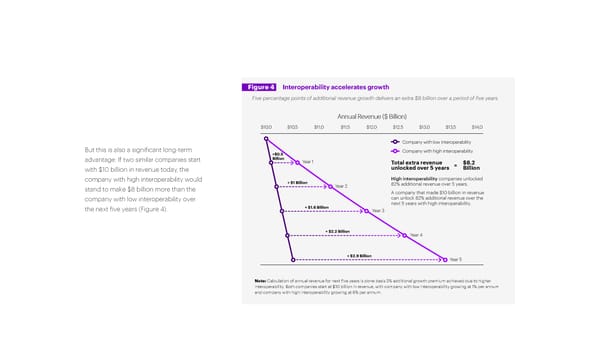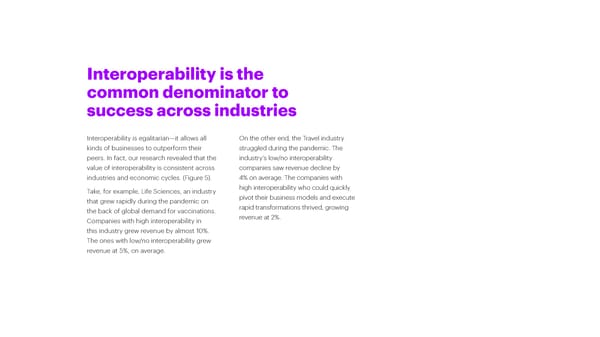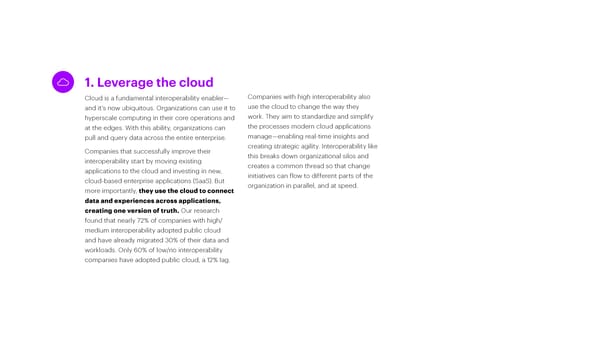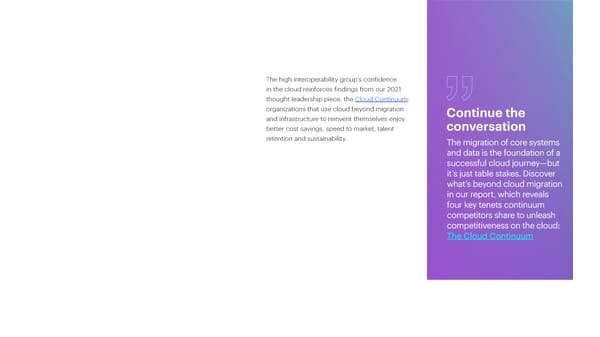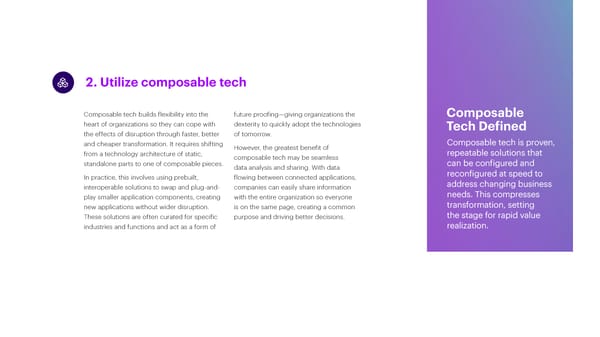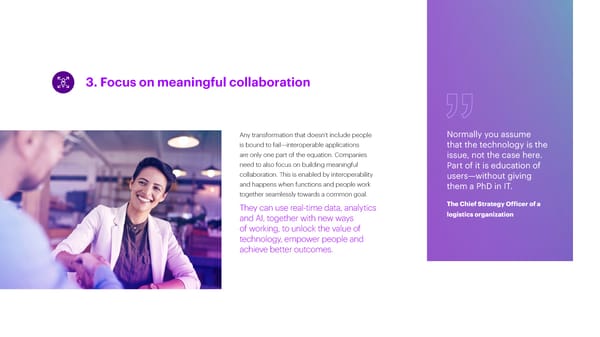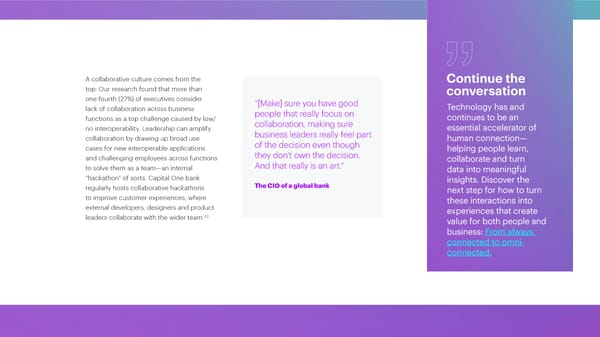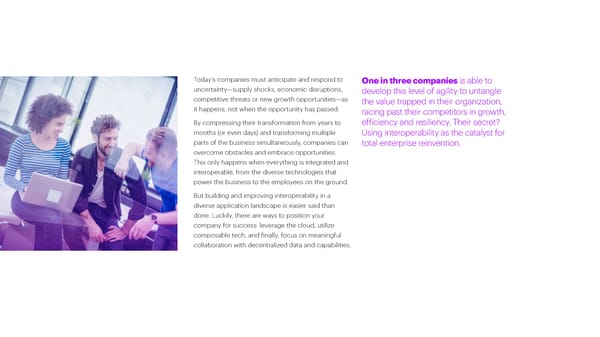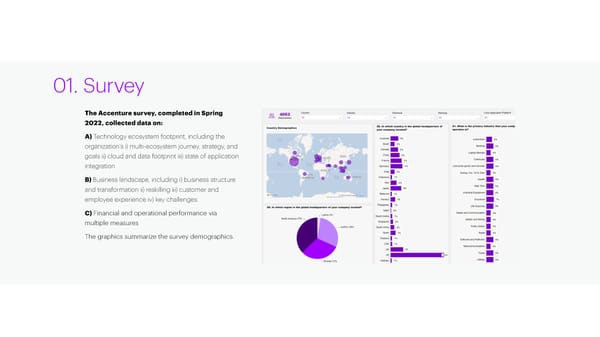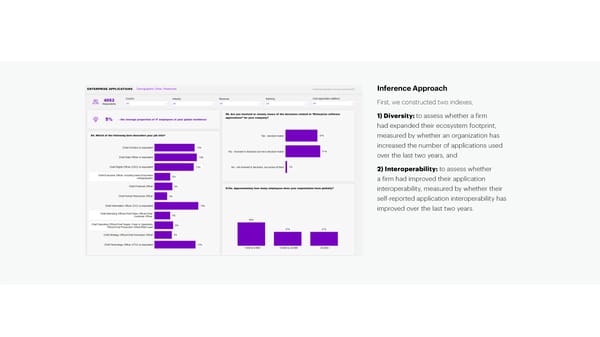Full Report
Value Untangled | Accelerating radical growth through interoperability
Accenture
Marketing
Interactive Content
Value Untangled
Technology
Interoperability
Sales
Agility
Cost
Value untangled Accelerating radical growth through interoperability From insights to action, the path to extraordinary value starts here.
Agility in times of uncertainty 03 Interoperability: the great unifier 05 How does interoperability create such far-reaching value? 07 Interoperability is now in reach 10 GN Group hits play on enterprise interoperability 11 Interoperability’s long-term value and low cost 12 Interoperability is the common denominator to success across industries 15 Qantas flies above the turbulence with operational interoperability 17 Contents Mazda fuels productivity with functional interoperability 19 Barriers to interoperability 20 ENGIE excels with a multi-vendor strategy 25 RetiPiù S.R.L. delivers with an SAP-centric strategy 25 How to improve interoperability and thrive in uncertainty 26 1. Leverage the cloud 28 2. Utilize composable tech 31 3. Focus on meaningful collaboration 33 Interoperability: Value untangled 37 Methodology 39
1. Agility in times of uncertainty 2 3 4 5 6 Agility in times of uncertainty
In an unpredictable world, the ability to quickly adapt to new circumstances, adopt new technologies and Figure 1 Uncertainty and compressed transformation otherwise remain nimble allows companies to thrive. In the last two years, one in two companies have had to transform multiple parts With the integration of these technologies, people and of their business at the same time or execute a single large transformation much processes, companies can untangle value from chaos faster than ever before. and accelerate growth. During the COVID-19 crisis, i.e., the last 2 years, my organization has (agree + strongly agree) To learn more about the value of agility, we surveyed 4,000+ C-suite respondents from mid- to large companies. We found that in the last two years alone, one in two have had to transform multiple parts of their business at the same time or execute a single large transformation much faster than ever before. We call this compressed transformation (Figure 1). N = 4053 Note: The percentages represent aggregate of respondents selecting “Agree” and “Strongly Agree” Note: The percentages represent aggregate of respondents selecting “Agree” and “Strongly Agree”
Interoperability: The great unifier We found that companies with this kind of agility have one thing in common: high interoperability, or the ability to make enterprise applications work in conjunction with each other. In fact, companies with high interoperability are 11% more likely to sustain compressed transformations. Why? Because interoperability integrates critical business applications, turning tangled inputs into a single source of data truth. This leaves organizations better equipped to pivot quickly and take advantage of new opportunities. And with that agility comes growth. In fact, we found that companies with high interoperability grew revenue 6X faster than their peers with low interoperability (Figure 2) and are set to unlock an additional five percentage points in annual revenue growth. It comes as no surprise, then, that winning companies keep interoperability top of mind for the entire C-suite—not just the CTO or CIO. CXOs need to understand that integrated enterprise applications can enable businesses to move from siloed technology and fragmented data to connected solutions, agility and resiliency. Integration creates true business transformation, creating additional value in meeting customer demands, developing new revenue streams, and competing in the market but requires new methods of thinking and working. 5
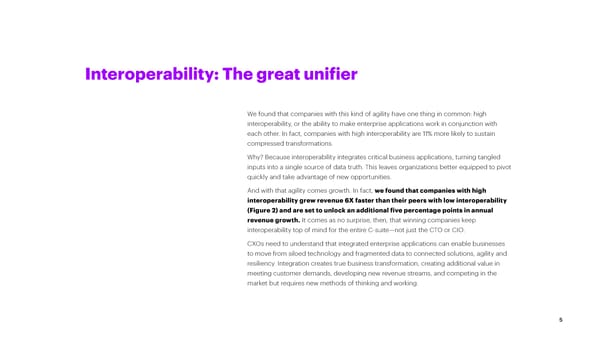
Figure 2 Interoperability accelerates growth That’s not all. Companies with high interoperability— especially those that manufacture, source or sell Companies with high interoperability unlocked up to five additional percentage points physical goods—also outpace companies with low/no of revenue growth than low/no interoperability companies stuck in the technology interoperability in profitability, resiliency and other value- status quo. Average revenue growth last FY (in %) creation measures critical to business. For example, we found that companies with high interoperability were: More efficient: 12 percentage points better at improving their supply chain and operations More successful at CX: 16 percentage points better at reinventing customer experience More productive: 12 percentage points more likely to be successful 6x 4x when improving employee productivity is a priority More sustainable: Source: Accenture Research based on Survey data. 4 percentage points more likely to be successful at Source: Accenture Research based on Survey data. Note: Additional growth rates due to increased platform exploration and seamless interoperability are Note: Additional growth rates due to increased platform exploration and seamless interoperability are estimates embracing sustainable business practices estimates based on an econometric model such as Revenue Growth i= A x medium interoperability + B x high based on an econometric model such as Revenue Growth i= A x medium interoperability + B x high interoperability interoperability + C controls + error, in which the baseline is the low/no interoperability group. Estimates include + C controls + error, in which the baseline is the low/no interoperability group. Estimates include a variety of a variety of firm-specific controls including industry, country, size, technology spending and an interaction firm-specific controls including industry, country, size, technology spending and an interaction term between term between industry and country. A variety of robustness checks have been performed (i.e., scaling revenue industry and country. A variety of robustness checks have been performed (i.e., scaling revenue growth by industry growth by industry averages, by previous growth rates and the results holds. Survey sample= 4,053 firms in 19 averages, by previous growth rates and the results holds. Survey sample= 4,053 firms in 19 industries and 23 industries and 23 countries. Revenue growth percentages have been rounded off to the nearest whole number. countries. Revenue growth percentages have been rounded off to the nearest whole number. Last FY implies the latest annual company financials reported before February 2022. Last FY implies the latest annual company financials reported before February 2022.
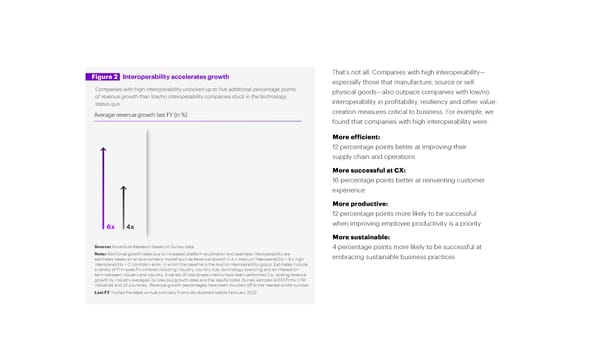
How does interoperability create such far- reaching value? At its core, interoperability connects technology, people and processes. It does so by creating a common language across critical applications and systems, enabling a deeper understanding of data without the cost and effort of building a data lake. When data silos are removed, functional silos can begin to collaborate. This inherent synergy reduces duplicative efforts, reveals hidden bottlenecks and builds better human connections, improving the following value drivers:

Figure 3 Real-world organizations untangling value via interoperability By connecting technology, people and processes, interoperability extracts value that’s often in sight, but tangled up in the organization. Interoperability Source: Source: GN Group: GN Group future-proofs its fast-growing operations with Microsoft Dynamics 365: https://customers.microsoft.com/en-us/ GN Group: GN Group future-proofs its fast-growing operations with Microsoft Dynamics 365: https://customers.microsoft.com/en-us/s- story/1354283595134173825-gn-group-consumer-goods-dynamics-365 tory/1354283595134173825-gn-group-consumer-goods-dynamics-365 Qantas: Qantas APIs take flight with WSO2 technology: https://wso2.com/about/customers/qantas/ Qantas: Qantas APIs take flight with WSO2 technology: https://wso2.com/about/customers/qantas/ GANT:GANT creates an omnichannel experience for a global customer base https://www.mulesoft.com/case-studies/api/gant GANT: GANT creates an omnichannel experience for a global customer base https://www.mulesoft.com/case-studies/api/gant Mazda:Mazda Motor Logistics speeds visibility across supply chain: https://www.oracle.com/customers/mazda/ Mazda: Mazda Motor Logistics speeds visibility across supply chain: https://www.oracle.com/customers/mazda/
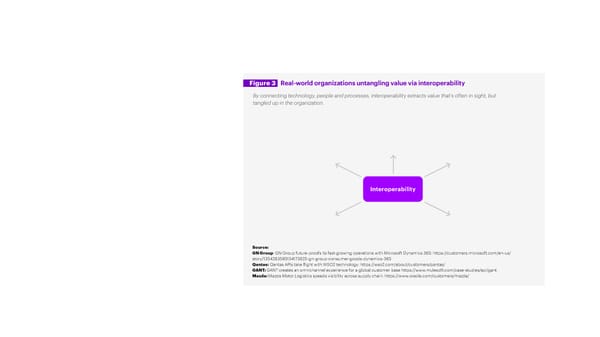
This is a modal window.
Interoperability is now in reach The concept of interoperability isn’t new, but the ability to manifest it is. This is due to three technology changes that make it easier for organizations to configure and reconfigure applications as needed without overhauling their digital core: 1. Ubiquity of cloud: Many organizations have already moved to the cloud, giving them a common data layer that provides a single source of truth. 2.Improved application design: Modern applications are designed to share data, they have simplified interfaces and support additional capabilities. 3.Low-cost applications: The large number of specialized applications on the market has reduced the cost.
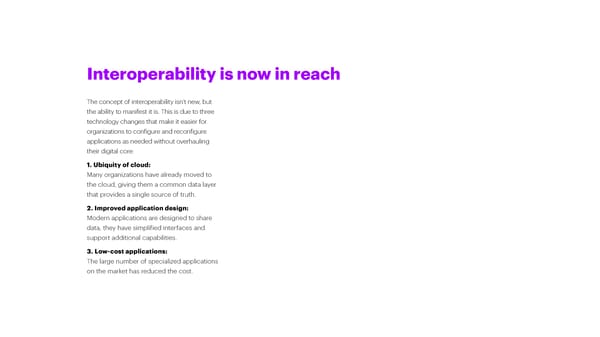
This is a modal window.
GN Group hits play on enterprise interoperability One company that truly understands the value of high interoperability is GN Group, a global audio solution manufacturer. Even before The New York Times declared its Jabra headset as the best on the market in spring 2021, GN Group braced for a demand surge by integrating its business applications under a unified strategy. Sales had jumped 82% in the first quarter of based enterprise solutions, the company pricing on the spot. Vendors and suppliers— 2021 on the heels of a 42% rise in 2020 when connected multiple functional applications—like typically late to learn about new demand—are COVID-19 influenced millions to buy headsets for supply chain operations and finance—to gain also in the loop and can now make their own remote school and work. Company leaders knew additional insights. This enabled parallel, rapid informed inventory decisions. this need would only grow with fast-changing transformation in multiple business areas. consumer behavior—and that GN Group’s Employees across the organization now make people and technology would play a critical role decisions based on a single source of trusted 1 in meeting the demand. Given the urgency, this data, and in real time. For example, if the sales transformation needed to happen quickly. team gets a large order, they can quickly check GN group turned to Microsoft, an enterprise if procurement has the available components applications partner. Using Microsoft’s cloud- and generate accurate timing estimates and
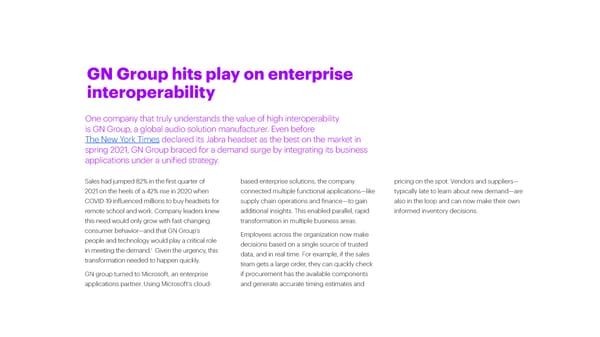
This is a modal window.
1 2. Interoperability’s long-term value and low cost 3 4 5 6 Interoperability’s long-term value and low cost
Figure 4 Interoperability accelerates growth Five percentage points of additional revenue growth delivers an extra $8 billion over a period of five years. Annual Revenue ($ Billion) $10,0 $10,5 $11,0 $11,5 $12,0 $12,5 $13,0 $13,5 $14,0 Company with low interoperability But this is also a significant long-term +$0.5 Company with high interoperability advantage: If two similar companies start Billion Year 1 Total extra revenue $8.2 with $10 billion in revenue today, the unlocked over 5 years = Billion company with high interoperability would + $1 Billion High interoperability companies unlocked stand to make $8 billion more than the Year 2 82% additional revenue over 5 years. A company that made $10 billion in revenue company with low interoperability over can unlock 82% additional revenue over the + $1.6 Billion next 5 years with high interoperability. the next five years (Figure 4). Year 3 + $2.2 Billion Year 4 + $2.9 Billion Year 5 Note: Calculation of annual revenue for next five years is done basis 5% additional growth premium achieved due to higher interoperability. Both companies start at $10 billion in revenue, with company with low interoperability Note: Calculation of annual revenue for next five years is done basis 5% additional growth premium achieved due to higher growing at 1% per annum and company with high interoperability growing at 6% per annum. interoperability. Both companies start at $10 billion in revenue, with company with low interoperability growing at 1% per annum and company with high interoperability growing at 6% per annum.
So how much does this all cost? The answer: Interoperability won’t break the bank. Our research shows that leading companies are able to achieve high interoperability with just 2-4% higher IT and functional budgets directed at applications, while handling as many (if not more) diverse applications within their IT stack.

This is a modal window.
Interoperability is the common denominator to success across industries Interoperability is egalitarian—it allows all On the other end, the Travel industry kinds of businesses to outperform their struggled during the pandemic. The peers. In fact, our research revealed that the industry’s low/no interoperability value of interoperability is consistent across companies saw revenue decline by industries and economic cycles. (Figure 5). 4% on average. The companies with Take, for example, Life Sciences, an industry high interoperability who could quickly that grew rapidly during the pandemic on pivot their business models and execute the back of global demand for vaccinations. rapid transformations thrived, growing Companies with high interoperability in revenue at 2%. this industry grew revenue by almost 10%. The ones with low/no interoperability grew revenue at 5%, on average.
Figure 5 Outperforming across industries Companies across industries—from Life Sciences to Travel—create value, in good times and bad, when they prioritize interoperability. Life Sciences Travel Average revenue growth last FY (in% ) Average revenue growth last FY (in %) 4.5pp of additional growth due to 6.4pp of plataform exploration additional and interoperability growth due to plataform exploration and interoperability Low/No High Low/No High Interoperability Interoperability Interoperability Interoperability N=244* N=250 N=244* N=250 *Note: Data for Life Sciences vertical excludes outliers – companies that grew applications Note: Last FY implies the latest annual company financials reported before February 2022. without increasing vendors (6 in total). *Note: Data for Life Sciences vertical excludes outliers – companies that grew applications Note: Last FY implies the latest annual company financials reported before February 2022. Last FY implies the latest annual company financials reported before February 2022. without increasing vendors (6 in total) . Last FY implies the latest annual company financials reported before February 2022.
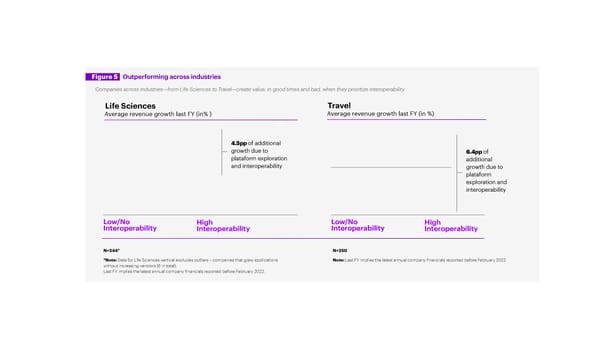
In depth Qantas flies above the turbulence with operational interoperability Qantas2, the flag carrier of Australia, is one of the few airlines that thrived despite the pandemic. In contrast to the global airline sector, which saw more than $174 billion in losses by the end of 2021, Qantas became more financially secure and witnessed a 120% stock price surge. How? The airline quickly pivoted to domestic Executing this compressed transformation was The airline operates in a diverse software travel when Australia shut down its borders in possible due to Qantas’s three-year recovery application environment. It has chosen SAP March 2020 and started subsidizing 800,000 plan. Launched in 2019, it lays out targeted Qualtrics4 to elevate its customer and employee half-priced airfares to support tourism. Qantas investments in digital and data capabilities experiences with newer technologies like AI- orchestrated its biggest network expansion in centered on creating a better customer based conversation surveys. a decade, adding 45 domestic routes. What’s experience through personalization, driving 5 It has also partnered with Workday to bring its more, after noticing a competitor significantly new operational efficiencies and broadening enterprise applications into the cloud and create scaling back operations, Qantas managed to the group’s earnings base beyond the core a single system for managing leaves, payroll, win over many of its frequent fliers—expanding aviation business3. recruitment, training, rewards and recognition. its own market share to 74%.
So how much does this all cost? The answer: Interoperability won’t break the bank. And like other companies with high interoperability, it also focuses on integration and interoperability across its applications and data. Using the WSO2 API Management platform6, the company has undergone a technology revamp to integrate applications and data with agility. In just 12 months, the company saw a tenfold increase in the number of connections (APIs) and 5X growth in the volume of communication that flows through these connections (managed API traffic), all at half of its legacy operating costs.
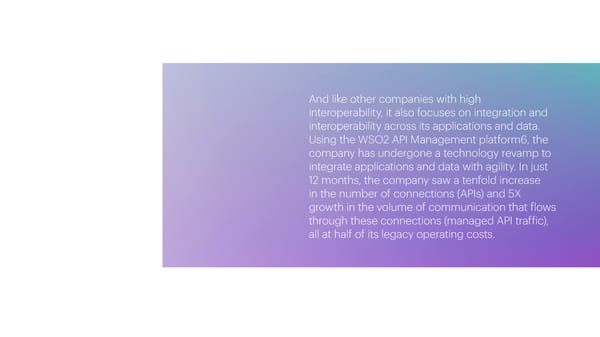
This is a modal window.
In depth Mazda fuels productivity with functional interoperability 7 Japanese automaker Mazda illustrates how The company relied on an integrated suite functional interoperability can transform of Oracle applications to manage orders and organizations. The company’s Motor Logistics inventory, warehouses and transportation. Now, division—which handles distribution of Mazda Mazda’s employees can easily follow products cars and parts throughout Europe—had from order to delivery. an issue: its warehouse wasn’t talking to its Most importantly, this strategy has changed transportation unit. how functional employees work. Mazda’s Mazda’s legacy warehouse management export staff can see carrier bookings, invoicing system lacked a transportation management and billing without logging out of software and module, leaving Mazda without visibility into report 75% higher productivity—from taking its product shipments. Unable to ensure on- four days to close the previous month’s books time delivery, Mazda risked leaving customers to less than a day. What’s more, reducing unsatisfied. Competitors could also threaten manual labor has allowed Mazda to redirect market share with non-Mazda-certified parts. resources to customer service.
1 2 3. Barriers to interoperability 4 5 6 Barriers to interoperability
Today’s business and technology landscape can make reaching high interoperability a challenge precisely because it can become a tangle very quickly. Most large enterprises have more than 500 applications, and eight out of 10 say they plan to buy more from multiple vendors in the next two years. At the same time, 66% say that the number of applications and their associated technical complexities are a barrier to reaching interoperability. The longer these organizations wait to make themselves interoperable, the more difficult it becomes to retrofit interoperability on an ever-growing application stack.

This is a modal window.
Financial tools are always provided by many vendors. We want to work with the best for key, bigger ERP applications and different applications have different pros and cons. So, you can’t actually just rely on one vendor to do everything. The CIO of a Southeast Asian Health Services Company
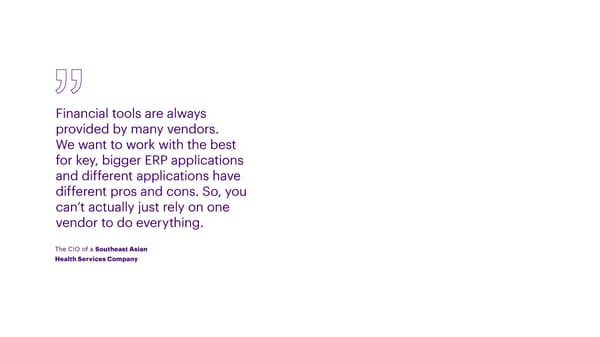
The second key factor is that more voices are involved in technology decision making. IDC, an industry analyst firm, believes that as many as 20 IT and line- of-business employees may be involved in technology 9 decision-making processes today. But having more choices and more voices can be a great thing. It allows organizations to choose tech with the right features for specific processes and differentiate across functions where it matters. For example, fraud detection applications in Banking need to be much more sophisticated than those in Food Retail. And in Healthcare, applications need the strongest data and privacy measures given the sensitive data they handle. Similarly, Consumer Goods companies need applications to enable near real-time social media monitoring so that they can launch new products and adjust current ones as trends quickly change or emerge.
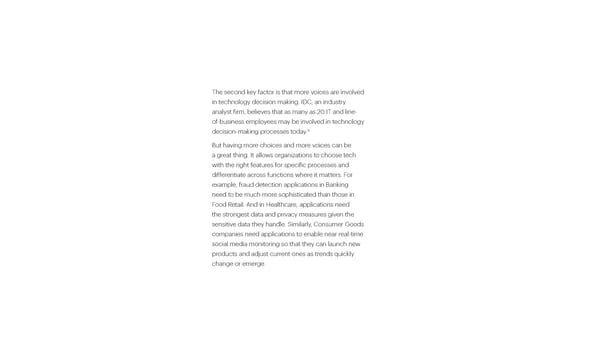
This is a modal window.
Companies with high interoperability also face these challenges. But what sets them apart is their ability to cope with obstacles by finding alignment across the business, acting early and making difficult decisions as needed. They build and reinforce technology integration with purposeful collaboration—intrinsic to employees’ work life. And most importantly, they back up their diverse application stacks with the right business strategy. One that is conscious of the organization’s full universe of applications and vendor selection style and recognizes the limitations of the IT team. Consider these two successful energy companies, each with high interoperability across their applications, but with different approaches tailored to their application buying preferences.
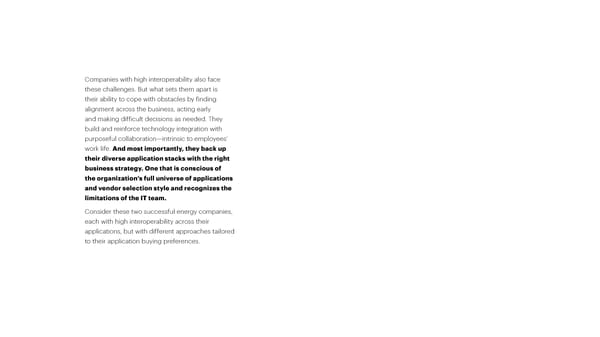
This is a modal window.
ENGIE excels with a multi-vendor strategy RetiPiù S.R.L. delivers with an SAP-centric strategy 16 The utility also uses the SAP Enterprise ENGIE, a French multinational utility, leverages In contrast, RetiPiù S.R.L., an Italian multiple applications from different providers energy company, relies on SAP for Asset Management solution to create to run its business, bring together 170,000 most of its applications. Its relatively digital twins for its equipment and employees across 70 countries and disseminate homogenous application stack builds activate predictive models. And it uses knowledge of customer needs. native interoperability among its SAP IoT solutions to gather detailed The company relies on: applications and allows it to transform sensor data from network equipment multiple parts of the business at the that it shares via mobile applications 10 • Salesforce for customer relationships 17 same time. with field technicians. • Oracle for talent management11 RetiPiù S.R.L. uses SAP S/4HANA and The company now receives 12 • Microsoft for employee experience SAP Intelligent Asset Management information and can update work 13 • SAP Concur for time and expenses applications to improve customer order statuses in real time. 14 experiences. This has unified its • SAP S/4 HANA on AWS Cloud for global finance The result? A 100% increase in ENGIE is deeply aware of its multi-provider intelligent asset maintenance system, the pieces of equipment it can 15 enabling better resource management application strategy and invests in Dell Boomi, and real-time mobile access. Field manage on the network— an integration provider that connects its diverse engineers can now remotely resolve from 12,000 to 24,000— stack together. issues and the company has achieved a and a 50% reduction in This works well for ENGIE: It has seen a 70% 20% improvement in capitalization. maintenance cost. growth in sales opportunities in the past couple of years, despite the pandemic.
1 2 3 4. How to improve interoperability and thrive in uncertainty 5 6 How to improve interoperability and thrive in uncertainty
Figure 6 How to improve your interoperability To improve interoperability and compress transformation, companies must leverage the cloud, utilize composable tech and focus on meaningful collaboration. Composable Tech Build repeatable solutions that can be configured and reconfigured at speed to address changing business needs Cloud Collaboration Use cloud as the foundation for Focus on empowering employees with shared data and experiences new digital skills, trusted collaboration across applications. and shared definition of success.
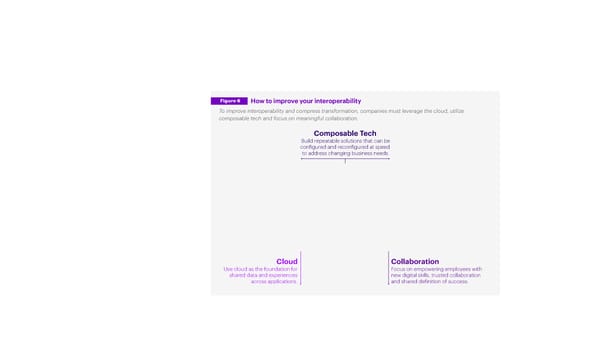
1. Leverage the cloud Cloud is a fundamental interoperability enabler— Companies with high interoperability also and it’s now ubiquitous. Organizations can use it to use the cloud to change the way they hyperscale computing in their core operations and work. They aim to standardize and simplify at the edges. With this ability, organizations can the processes modern cloud applications pull and query data across the entire enterprise. manage—enabling real-time insights and Companies that successfully improve their creating strategic agility. Interoperability like interoperability start by moving existing this breaks down organizational silos and applications to the cloud and investing in new, creates a common thread so that change cloud-based enterprise applications (SaaS). But initiatives can flow to different parts of the more importantly, they use the cloud to connect organization in parallel, and at speed. data and experiences across applications, creating one version of truth. Our research found that nearly 72% of companies with high/ medium interoperability adopted public cloud and have already migrated 30% of their data and workloads. Only 60% of low/no interoperability companies have adopted public cloud, a 12% lag.
The more you can be standard, the better you are able to answer questions and get things done… the easier it’s going to be to do everything. The CIO of an American Bank
The high interoperability group’s confidence in the cloud reinforces findings from our 2021 thought leadership piece, the Cloud Continuum: organizations that use cloud beyond migration Continue the and infrastructure to reinvent themselves enjoy conversation better cost savings, speed to market, talent retention and sustainability. The migration of core systems and data is the foundation of a successful cloud journey—but it’s just table stakes. Discover what’s beyond cloud migration in our report, which reveals four key tenets continuum competitors share to unleash competitiveness on the cloud: The Cloud Continuum
2.Utilize composable tech Composable tech builds flexibility into the future proofing—giving organizations the Composable heart of organizations so they can cope with dexterity to quickly adopt the technologies Tech Defined the effects of disruption through faster, better of tomorrow. and cheaper transformation. It requires shifting However, the greatest benefit of Composable tech is proven, from a technology architecture of static, composable tech may be seamless repeatable solutions that standalone parts to one of composable pieces. data analysis and sharing. With data can be configured and In practice, this involves using prebuilt, flowing between connected applications, reconfigured at speed to interoperable solutions to swap and plug-and- companies can easily share information address changing business play smaller application components, creating with the entire organization so everyone needs. This compresses new applications without wider disruption. is on the same page, creating a common transformation, setting These solutions are often curated for specific purpose and driving better decisions. the stage for rapid value industries and functions and act as a form of realization.
18 API (developed with MuleSoft) running the GANT GANT, a global fashion retailer, wanted to provide a consistent omnichannel experience integration center, which governs and drives the Continue the to keep pace with changing customer transformation through integrations. It allows GANT to conversation preferences. But in the process, GANT remove complexity from various systems and ensure The ability to adapt to spotted a major missed opportunity. Its data was available to different lines of business and website showed queried items as out of stock entirely new channels, like mobile or in-store kiosks. changing business needs when they might actually be available in a GANT can also reuse assets across projects. at speed and scale is nearby store. This is a negative experience for The success of the OSSC was due to key to staying market customers, and ultimately a profit loss for the API-led connectivity. Because the retail relevant. Discover how company. GANT proposed a solution called industry is so dynamic, time was of the to accelerate the path to the “Online Store Stock Check” (OSSC) where essence for GANT to implement these value through a data-led customers can search for a particular item omnichannel features. Thanks to its transformation enabled online and get a list of nearby stores where foundational architecture and reusable with prebuilt, interoperable the item is available. assets, the retailer rolled out the OSSC and repeatable solutions: Projects like the OSSC were critical to solution across five different markets Composable Tech meeting omnichannel expectations and three times faster than if it had used GANT knew there would be similar projects traditional point-to-point integration. in the future. So, the retailer created a foundational architecture with a system
3.Focus on meaningful collaboration Any transformation that doesn’t include people Normally you assume is bound to fail—interoperable applications that the technology is the are only one part of the equation. Companies issue, not the case here. need to also focus on building meaningful Part of it is education of collaboration. This is enabled by interoperability users—without giving and happens when functions and people work them a PhD in IT. together seamlessly towards a common goal. They can use real-time data, analytics The Chief Strategy Officer of a and AI, together with new ways logistics organization of working, to unlock the value of technology, empower people and achieve better outcomes.
So how much does this all cost? The answer: Interoperability won’t break the bank. Companies with high interoperability have an unwavering focus on improving human connections with trust and skills. They continuously invest in pervasive training, empowering IT and non-IT decision makers to make sound application choices. They also build data-sharing mindsets to prevent data hoarding. Companies with high interoperability are open to sharing data inside and outside the organization. Decentralized data—where everyone is on the same page—helps companies find harmony. The result is happier, more productive employees who can easily use company data to produce meaningful results, prepare presentations, comply with regulation or simply collaborate. As mentioned above, decentralized data also frees up almost two hours of employees’ workdays in productivity alone. For a company that has 10,000 employees, this amounts to a productivity gain of 19 almost 15,000 hours and $100 million every year.
We needed a way to break down data silos between functions. With interoperability, we developed a better working relationship between functions and unlocked the potential of the company to see how different functions impact it. We were very siloed: you toss it over the wall to the other function, you don’t even hand it to them. In terms of the hard metrics, I think you’re able to see that your finance understands the product line and their data is shared better. Now that we’ve had that cross-data being shared, we’ve saved money. I think we can point to a lot of different wins where we’ve unlocked value by sharing data, information and knowledge. I think once you’re there, you’re doing well. An automotive manufacturer’s CIO
A collaborative culture comes from the Continue the top: Our research found that more than conversation one fourth (27%) of executives consider “[Make] sure you have good lack of collaboration across business people that really focus on Technology has and functions as a top challenge caused by low/ collaboration, making sure continues to be an no interoperability. Leadership can amplify business leaders really feel part essential accelerator of collaboration by drawing up broad use of the decision even though human connection— cases for new interoperable applications they don’t own the decision. helping people learn, and challenging employees across functions And that really is an art.” collaborate and turn to solve them as a team—an internal data into meaningful “hackathon” of sorts. Capital One bank insights. Discover the regularly hosts collaborative hackathons The CIO of a global bank next step for how to turn to improve customer experiences, where these interactions into external developers, designers and product experiences that create leaders collaborate with the wider team.20 value for both people and business: From always connected to omni- connected.
1 2 3 4 5. Interoperability: Value untangled 6 Interoperability: Value untangled
Today’s companies must anticipate and respond to One in three companies is able to uncertainty—supply shocks, economic disruptions, develop this level of agility to untangle competitive threats or new growth opportunities—as the value trapped in their organization, it happens, not when the opportunity has passed. racing past their competitors in growth, By compressing their transformation from years to efficiency and resiliency. Their secret? months (or even days) and transforming multiple Using interoperability as the catalyst for parts of the business simultaneously, companies can total enterprise reinvention. overcome obstacles and embrace opportunities. This only happens when everything is integrated and interoperable, from the diverse technologies that power the business to the employees on the ground. But building and improving interoperability in a diverse application landscape is easier said than done. Luckily, there are ways to position your company for success: leverage the cloud, utilize composable tech, and finally, focus on meaningful collaboration with decentralized data and capabilities.
1 2 3 4 5 6. Methodology Methodology
01. Survey The Accenture survey, completed in Spring 2022, collected data on: A)Technology ecosystem footprint, including the organization’s i) multi-ecosystem journey, strategy, and goals ii) cloud and data footprint iii) state of application integration B)Business landscape, including i) business structure and transformation ii) reskilling iii) customer and employee experience iv) key challenges. C)Financial and operational performance via multiple measures The graphics summarize the survey demographics.
Inference Approach First, we constructed two indexes, 1) Diversity: to assess whether a firm had expanded their ecosystem footprint, measured by whether an organization has increased the number of applications used over the last two years, and 2)Interoperability: to assess whether a firm had improved their application interoperability, measured by whether their self-reported application interoperability has improved over the last two years.
Using these two indexes as dummy variables, interoperability), and finally, one that was leading we grouped all 4,053 respondents into three in terms of both ecosystem expansion and groups. The first group, which had not improved integration across these ecosystems (companies Diversity over the last two years, regardless with high interoperability). of their Interoperability score, was named We then investigated how being in companies with low/no interoperability. The each group correlates to measures of second group, which had improved Diversity performance. but not improved its Interoperability was called companies with medium interoperability. The Calculation of the Performance remaining respondents, who had improved both Difference their Diversity and Interoperability were named Using the definitions above, we compared the high interoperability. Each group had roughly a difference in performance between these three third of the respondents (~33%, or 1330). In other groups—with metrics such as cost savings, words, we identified three equal sized groups revenue growth, employee productivity, and of companies, one of which was in ecosystem how successful they have been at achieving stasis (companies with low/no interoperability), business goals such as reinventing customer one that was expanding ecosystems but not experience and achieving efficiency in supply improving integration (companies with medium chain operations.
02.Interviews and Studies We triangulated our findings from the survey’s large- scale primary data with 25 in-depth interviews and 40 case studies. Overall, we collected through secondary research and interviews about 65 case studies focusing on issues organizations are facing on their multi-ecosystem journey and the evolution of organizations toward the multi-ecosystem world. To analyse the qualitative data (QDA) of the 25 in- depth interviews, we leveraged ATLAS.ti21 , a tool that accelerates the QDA by automatically generating deep insights across the interview transcripts.
03. Collective Intelligence via an Enterprise Crowdsourcing Platform To understand the organizational and human own ideas, rated the thoughts others have implications of multiple ecosystems, we used provided on a scale of one to five stars, and 22 ThoughtExchange , a qualitative platform viewed how the thoughts in the exchange were designed to bring people together on important rated by the group. topics and gain their collaborative insights. Thirty-five C-suite participants were asked to share their ideas in response to an open-ended Through this process, we aimed to question on how their organization increases surface the practices that are top- cross-functional alignment (organizational of-mind for C-suite executives as a impact of integration) while preserving the collaborative effort and enrich our unique features of each function (organizational storyline. impact of diversity). Participants shared their
Authors Emma McGuigan Jan van den Bremen Brian McKillips Global Lead Europe Lead Growth & Strategy Lead Enterprise & Industry Enterprise & Industry Enterprise & Industry Technologies Technologies Technologies Emma McGuigan leads Enterprise & Industry Jan leads Enterprise & Industry Technologies Brian leads Enterprise & Industry Technologies Technologies, which helps clients achieve in Europe, which helps clients achieve enterprise- strategy, as well as the Connected Solutions enterprise-wide transformation by bringing wide transformation by bringing Accenture’s deep group. He helps businesses solve some of their Accenture’s deep technology, functional and technology, functional and industry expertise across greatest challenges by driving accelerated digital industry expertise across SAP, Microsoft, Oracle, leading platforms. He is a member of Accenture’s transformation and exploring new ways to employ Salesforce, Workday, Adobe and other leading Europe Management Committee (EMC) and technology to meet their business goals. platforms. For these IPS platforms, Emma oversees Accenture’s Global Leadership Committee (GLC). Accenture’s relationships, strategy and capabilities globally and across all industries. She is a member of Accenture’s Global Management Committee.
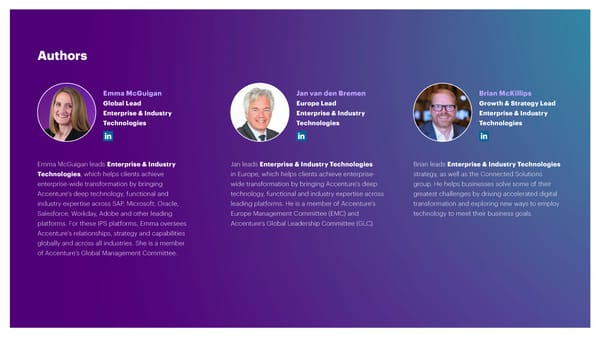
Authors Pradeep Roy Surya Mukherjee Project Team: Research Lead Research Lead Ajay Garg Global Europe Chiara Addis Technology Technology Ezequiel Tacsir Gargi Chakrabarty Jakub Wiatrak Krish Jhaveri Pradeep Roy is a Managing Director at Accenture Surya Mukherjee is a Senior Principal at Mariusz Bidelski and leads global Technology Research. He Accenture and Head of Technology Research Mélina Viglino is most active on topics which explore the for Europe. He has over two decades of Sandra Najem innovation potential of technology to drive experience as an advisor to platform Shachi Jain business reinvention and enable socio-economic providers and their users and has been Acknowledgments: transformation to create 360-degree value. quoted on the Wall Street Journal, ZDnet and Salena Gallo Computer Weekly. His interest lies in exploring Jennifer Cronin the transformative impact of technologies on Shannon Mapp industries, companies, and brands.
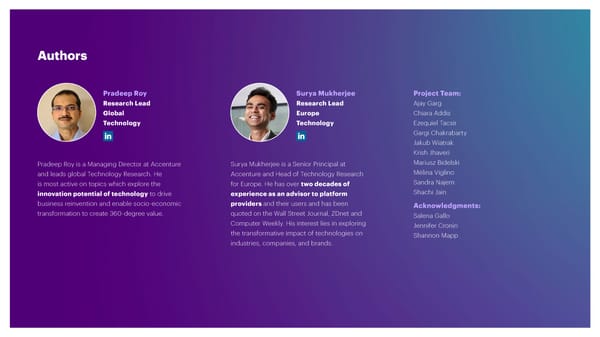
References 1 GN Group future-proofs its fast-growing operations with Microsoft Dynamics 365: https://customers.microsoft.com/en-us/story/1354283595134173825-gn-group-consumer-goods-dynamics-365 2 One Airline Is Set to Emerge From Covid Stronger Than Ever: https://www.bloomberg.com/news/articles/2021-06-23/one-airline-is-set-to-emerge-from-covid-mess-stronger-than-ever 3 Digitalisation and big data: https://www.qantas.com/in/en/qantas-group/looking-ahead/digitalisation-and-big-data.html 4 Qantas opens throttle on ‘Voice of the Customer’: https://www.itnews.com.au/news/qantas-opens-throttle-on-voice-of-the-customer-526585 5 Qantas signs on with Oracle and SAP rival Workday in cloud modernisation push: https://www.afr.com/technology/qantas-signs-on-with-oracle-and-sap-rival-workday-in-cloud-modernisation-push-20160912-gren2t 6 Qantas APIs take flight with WSO2 technology: https://wso2.com/about/customers/qantas/ 7 Mazda Motor Logistics speeds visibility across supply chain: https://www.oracle.com/customers/mazda/ 8 Marketing Technology Landscape 2022: https://chiefmartec.com/2022/05/marketing-technology-landscape-2022-search-9932-solutions-on-martechmap-com/ 9 Digital Innovation Requires Enterprise Application Vendors to Focus on What Matters: https://blogs.idc.com/2021/01/08/digital-innovation-requires-enterprise-application-vendors-to-focus-on-what-matters/ 10 How Engie is building a sustainable future by unifying its data: https://www.salesforce.com/fr/resources/articles/engie/ 11 Oracle Helps ENGIE Manage Its 170,000 Strong Workforce: https://www.prnewswire.com/news-releases/oracle-helps-engie-manage-its-170-000-strong-workforce-301202203.html 12 ENGIE IT implements a Microsoft “modern workplace” within the ENGIE group https://customers.microsoft.com/fr-FR/story/1374632648431300901-engie-it-professional-services-microsoft365-fr-france 13 ENGIE makes its digital transformation with SAP Concur https://news.sap.com/france/2019/06/engie-fait-sa-transformation-digitale-avec-sap-concur/ 14 ENGIE Seeks to Digitally Transform and Streamline Financial Processes Using SAP S/4HANA on AWS https://aws.amazon.com/solutions/case-studies/engie/ 15 Boomi integration drives business agility and digital transformation for ENGIE: https://boomi.com/customer/engie/ 16 How Does a Next-Generation ERP Solution Illuminate the Path to Smarter Energy? https://news.sap.com/2021/12/european-utilities-company-retipiu-makes-maintenance-efficient-transparent-cost-effective/ 17 How a European Utilities Company Makes Maintenance More Efficient, Transparent, and Cost-Effective https://news.sap.com/2021/12/european-utilities-company-retipiu-makes-maintenance-efficient-transparent-cost-effective/ 18 GANT creates an omnichannel experience for a global customer base https://www.mulesoft.com/case-studies/api/gant 19 Based on average wages per hour data from US Bureau of Labor Statistics (https://www.bls.gov/news.release/empsit.t19.htm). Calculation: Productivity gain with interoperability x Average hours worked per day per employee (8 hrs) x No. of employees (10,000) x No. of working days in a year (260) x Average wages per hour ($32 as of June 2022 per US Bureau of Labor Statistics) 20 How Hackathons Support Lifelong Learning (https://www.capitalone.com/tech/software-engineering/how-hackathons-support-lifelong-learning-and-innovation/) 21 ATLAS.ti: https://atlasti.com/ 22 ThoughtExchange: https://thoughtexchange.com/about/
About Accenture About Accenture Research Accenture is a global professional services company with leading capabilities in Accenture Research creates thought leadership about the most pressing business digital, cloud and security. Combining unmatched experience and specialized skills issues organizations face. Combining innovative research techniques, such as data across more than 40 industries, we offer Strategy and Consulting, Technology and science led analysis, with a deep understanding of industry and technology, our team Operations services and Accenture Song — all powered by the world’s largest network of 300 researchers in 20 countries publish hundreds of reports, articles, and points of Advanced Technology and Intelligent Operations centers. Our 710,000 people of view every year. Our thought-provoking research developed with world leading deliver on the promise of technology and human ingenuity every day, serving clients in organizations helps our clients embrace change, create value, and deliver on the more than 120 countries. We embrace the power of change to create value and shared power of technology and human ingenuity. success for our clients, people, shareholders, partners and communities.. For more information, visit www.accenture.com/research. Visit us at www.accenture.com. This content is provided for general information purposes and is not intended to be Copyright © 2022 Accenture. used in place of consultation with our professional advisors. This document refers All rights reserved. to marks owned by third parties. All such third-party marks are the property of their Accenture and its logo are registered respective owners. No sponsorship, endorsement, or approval of this content by the trademarks of Accenture owners of such marks is intended, expressed, or implied.

